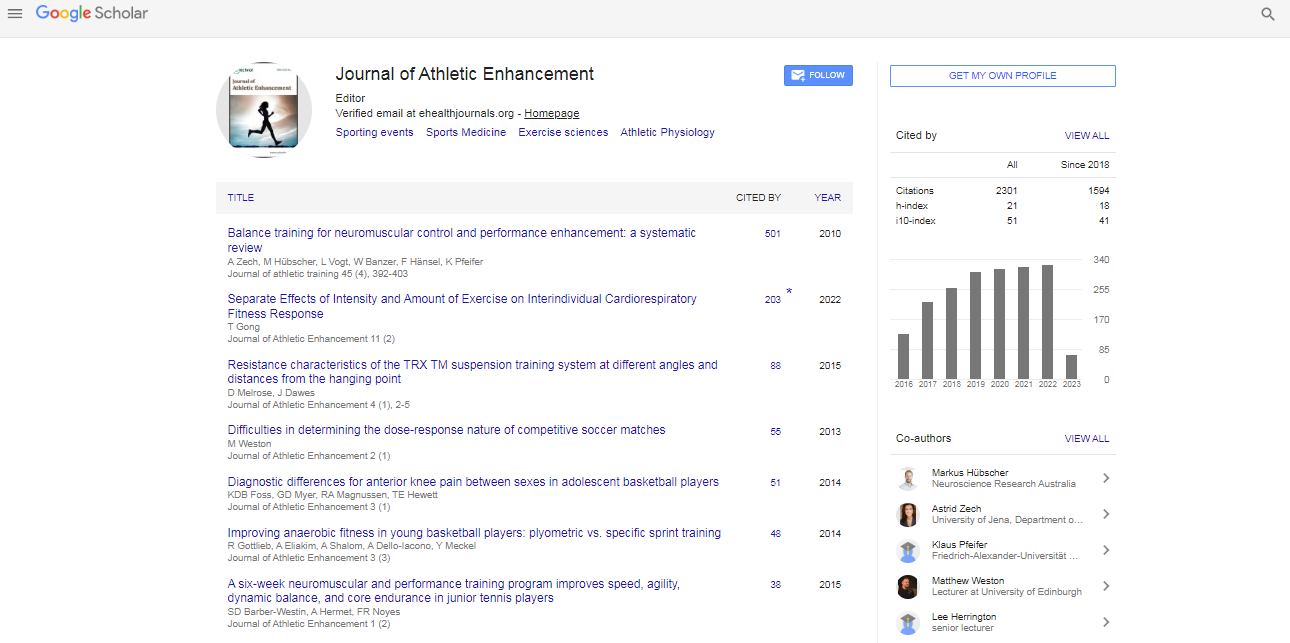Opinion Article, J Athl Enhanc Vol: 13 Issue: 6
Athletic Physiology: The Science behind Athletic Performance
Andrea Goor*
1Department of Public Health, VU University Medical Center, Amsterdam, The Netherlands
*Corresponding Author: Andrea Goor,
Department of Public Health, VU University
Medical Center, Amsterdam, The Netherlands
E-mail: goorandrea@edu.nl
Received date: 28 October, 2024, Manuscript No. JAE-24-153712;
Editor assigned date: 31 October, 2024, PreQC No. JAE-24-153712 (PQ);
Reviewed date: 14 November, 2024, QC No. JAE-24-153712;
Revised date: 21 November, 2024, Manuscript No. JAE-24-153712 (R);
Published date: 28 November, 2024 DOI: 10.4172/2324-9080.1000157
Citation: Goor A (2024) Athletic Physiology: The Science Behind Athletic Performance. J Athl Enhanc 13:6.
Description
Athletic physiology is a branch of science that focuses on the physical processes and systems that are at work during exercise and athletic performance. It is concerned with how the human body responds to various forms of physical stress, the adaptations that occur with training and how athletes can optimize their physical performance. The science of athletic physiology spans several areas, including energy production, muscular function, cardiovascular health, respiratory efficiency and recovery. Understanding these physiological processes is important for athletes, coaches and sports scientists to design effective training programs and maximize performance while minimizing the risk of injury.
At the core of athletic physiology is the body’s ability to produce and utilize energy. During physical activity, muscles require energy to contract and generate force. This energy primarily comes from Adenosine Triphosphate (ATP), which is the body’s main energy carrier. ATP is produced through several energy systems, which include the phosphagen system, glycolysis and oxidative phosphorylation. The choice of energy system depends on the intensity and duration of the activity. Short bursts of intense activity, such as sprinting, rely on the phosphagen system, which provides immediate energy but is limited in duration. On the other hand, longer activities, like marathon running, rely on oxidative phosphorylation, which uses oxygen to produce ATP and can sustain energy production over extended periods.
Training plays a key role in enhancing the efficiency of these energy systems. For example, endurance training increases the number and size of mitochondria in muscle cells, which improves the muscle’s ability to utilize oxygen and produce ATP through oxidative phosphorylation. Similarly, strength training enhances the phosphagen system by increasing the muscle’s ability to store and rapidly use ATP. Through consistent and specific training, athletes can improve their efficiency in utilizing these energy pathways, enabling them to perform at higher intensities for longer periods.
Muscular function is another important aspect of athletic physiology. Skeletal muscles are responsible for producing force and movement and their ability to do so is influenced by both the muscle fibers involved and the neural control of muscle contractions. Muscles consist of different types of fibers, including slow-twitch fibers (Type I) and fast-twitch fibers (Type II). Slow-twitch fibers are more resistant to fatigue and are primarily used in endurance activities, such as long-distance running. These fibers rely heavily on aerobic metabolism to produce energy. In contrast, fast-twitch fibers are used in short, explosive movements, such as sprinting or weightlifting and are capable of generating greater force but fatigue more quickly. Fasttwitch fibers rely more on anaerobic metabolism, which does not require oxygen and produces energy more rapidly, albeit for shorter durations.
In conclusion, athletic physiology is a comprehensive field that examines how the body responds to physical exertion and how it can be trained to perform at its peak. By understanding the interactions between energy production, muscular function, cardiovascular and respiratory health and recovery, athletes and coaches can design training programs that optimize performance and minimize injury risks. The application of these principles, combined with knowledge of individual differences, can help athletes achieve their goals, whether they are running a marathon, lifting weights, or competing in team sports. Ultimately, athletic physiology is the key to unlocking the full potential of the human body in sports and physical activity.
 Spanish
Spanish  Chinese
Chinese  Russian
Russian  German
German  French
French  Japanese
Japanese  Portuguese
Portuguese  Hindi
Hindi 
